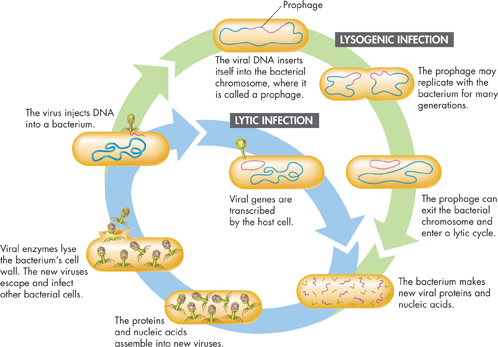Lysogenic Infection Some bacterial viruses, including the bacteriophage lambda, cause a lysogenic infection, in which a host cell is not immediately taken over. Instead, the viral nucleic acid is inserted into the host cell's DNA, where it is copied along with the host DNA without damaging the host. Viral DNA multiplies as the host cells multiply. In this way, each generation of daughter cells derived from the original host cell is infected.
BUILD Vocabulary
WORD ORIGINS The adjective lytic, the verb lyse, and the prefix lyso - all come from the Greek word lyein, meaning “to loosen or break up.”
Bacteriophage DNA that becomes embedded in the bacterial host's DNA is called a prophage. The prophage may remain part of the DNA of the host cell for many generations. Influences from the environment—including radiation, heat, and certain chemicals—trigger the prophage to become active. It then removes itself from the host cell DNA and directs the synthesis of new virus particles. The lysogenic infection now becomes an active lytic infection, as shown in Figure 20–3.
The details of viral infection in eukaryotic cells differ in many ways from viral infection of bacteria by bacteriophages. But for the most part, the basic patterns of infection in animals and other eukaryotes are similar to the lytic and lysogenic infections of bacteria.
 In Your Notebook Describe how a lysogenic infection can change into a lytic infection.
In Your Notebook Describe how a lysogenic infection can change into a lytic infection.

FIGURE 20–3 Comparing Two Types of Bacteriophage Infection Viruses that infect bacteria, called bacteriophages, may infect cells in one of two ways: lytic infection or lysogenic infection.
d
Table of Contents
- Formulas and Equations
- Applying Formulas and Equations
- Mean, Median, and Mode
- Estimation
- Using Measurements in Calculations
- Effects of Measurement Errors
- Accuracy
- Precision
- Comparing Accuracy and Precision
- Significant Figures
- Calculating With Significant Figures
- Scientific Notation
- Calculating With Scientific Notation
- Dimensional Analysis
- Applying Dimensional Analysis




